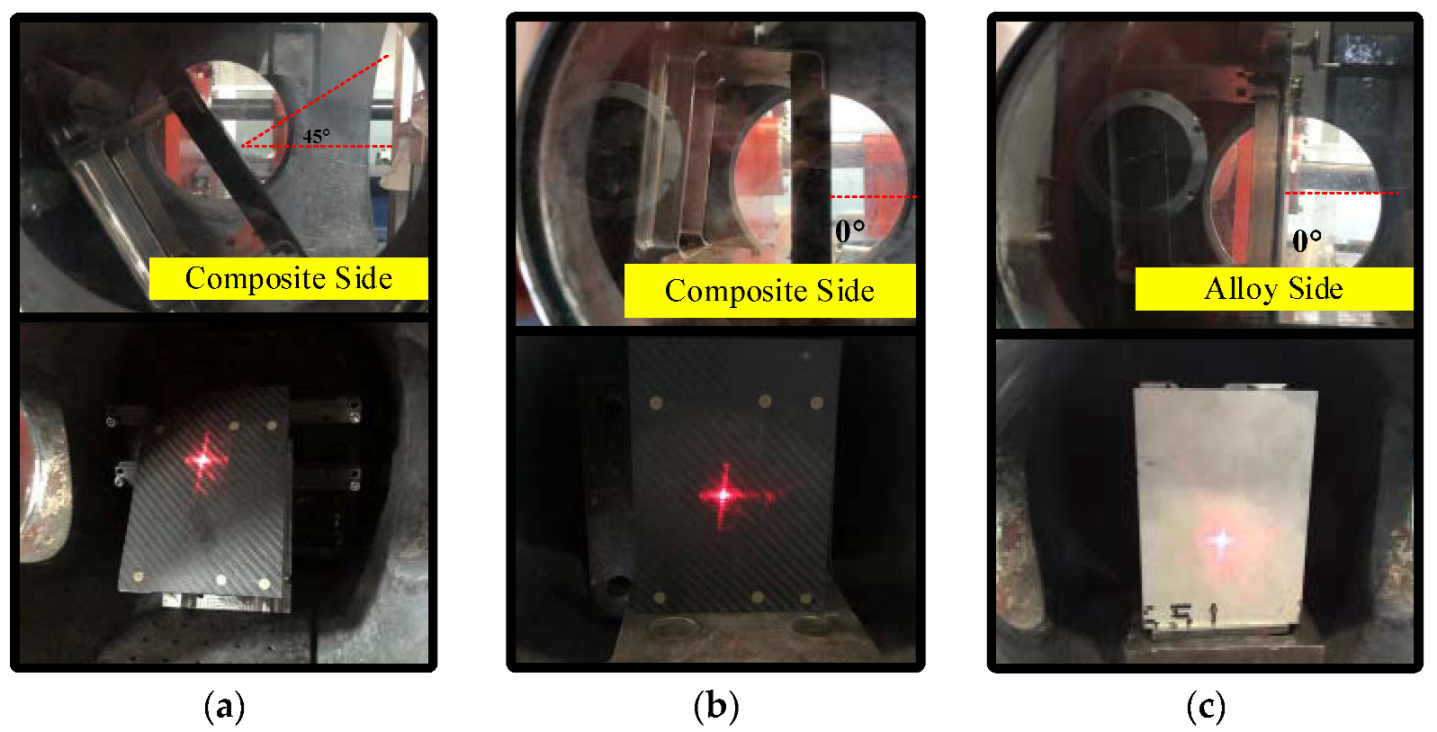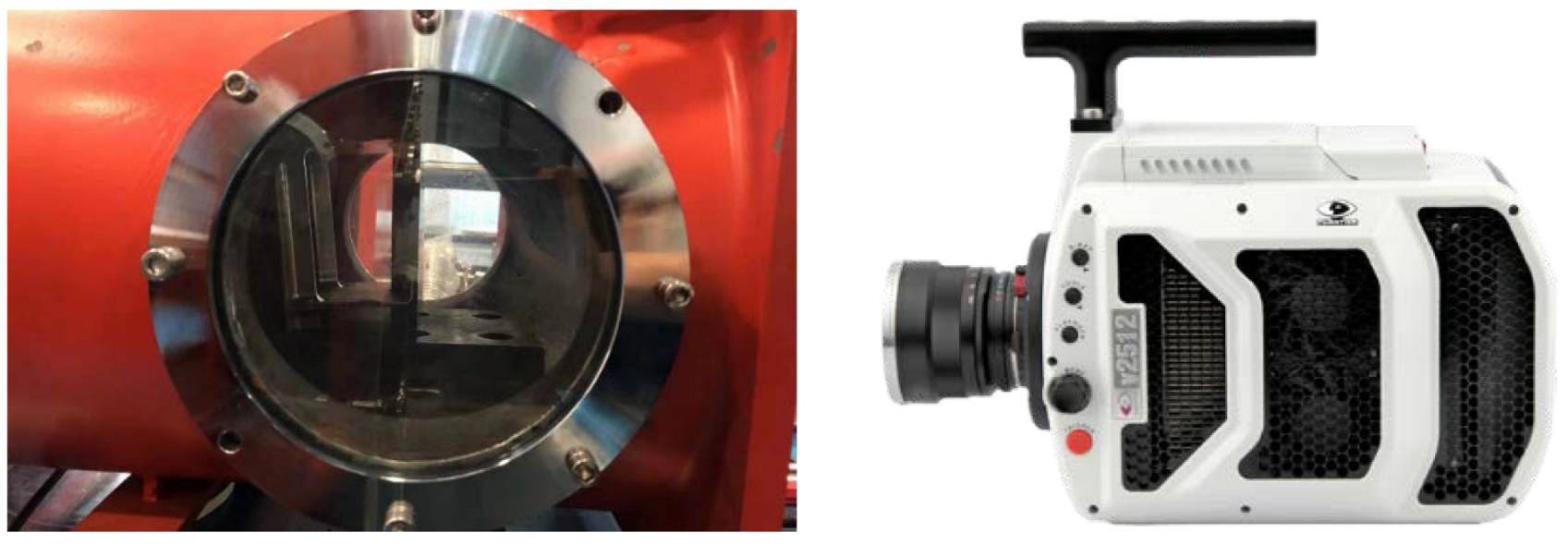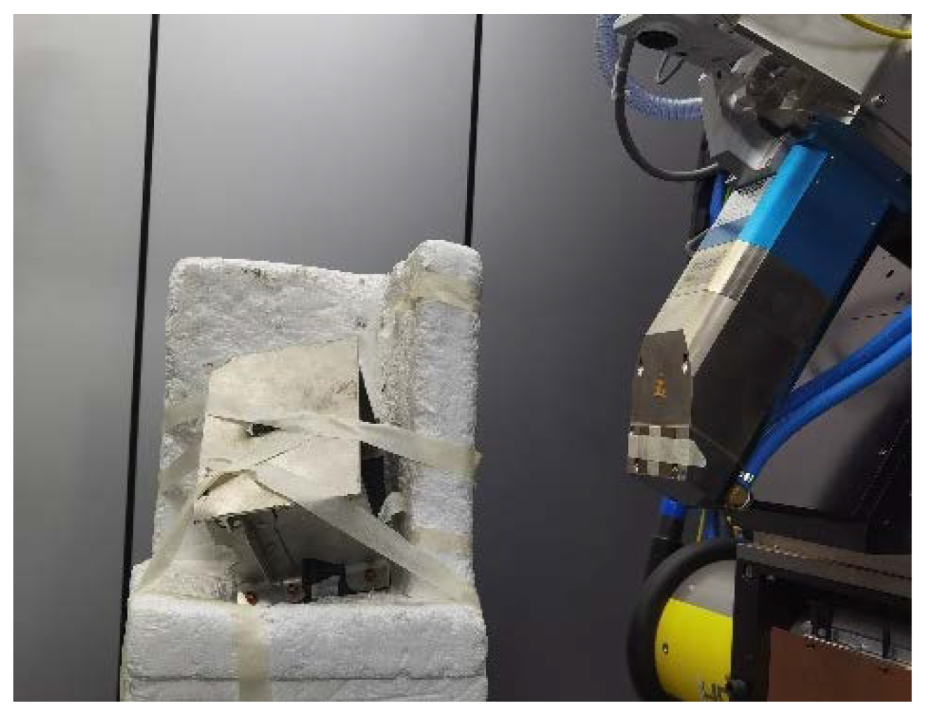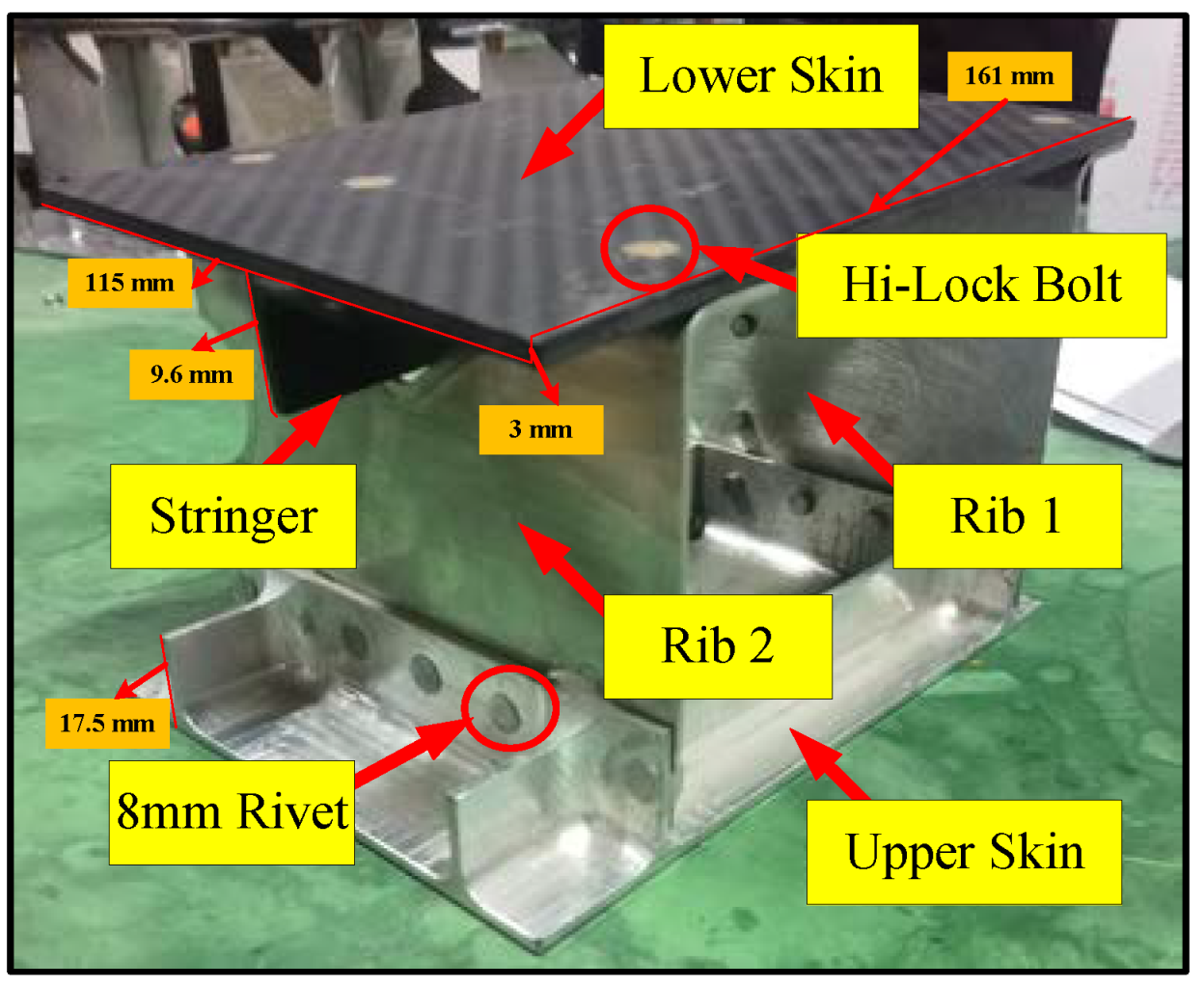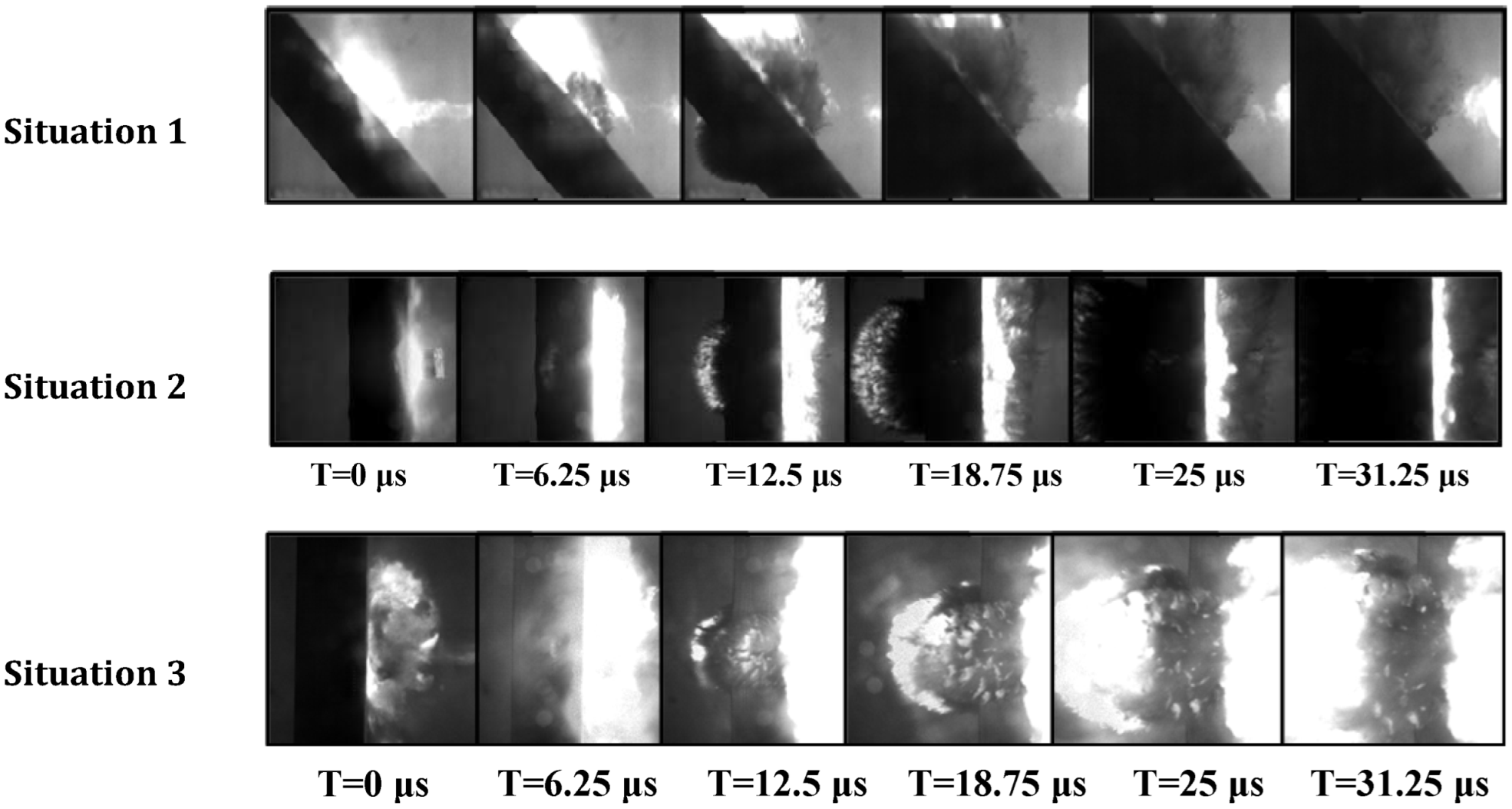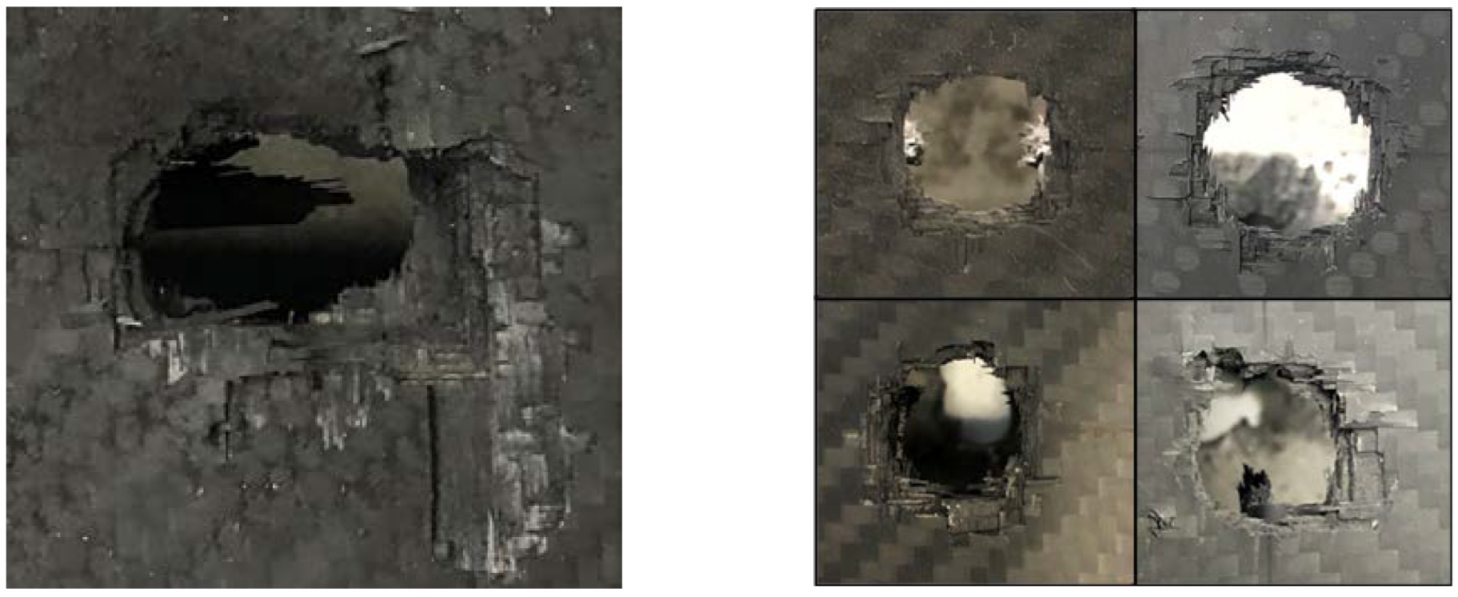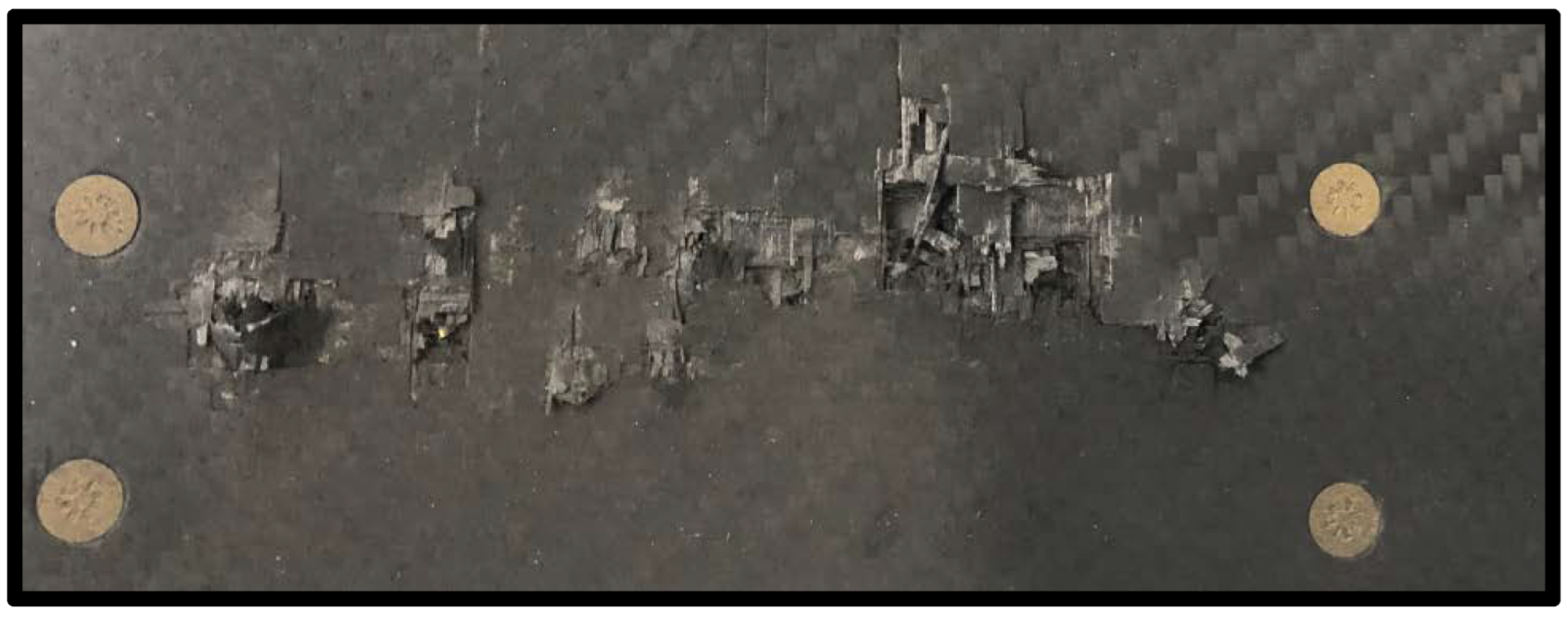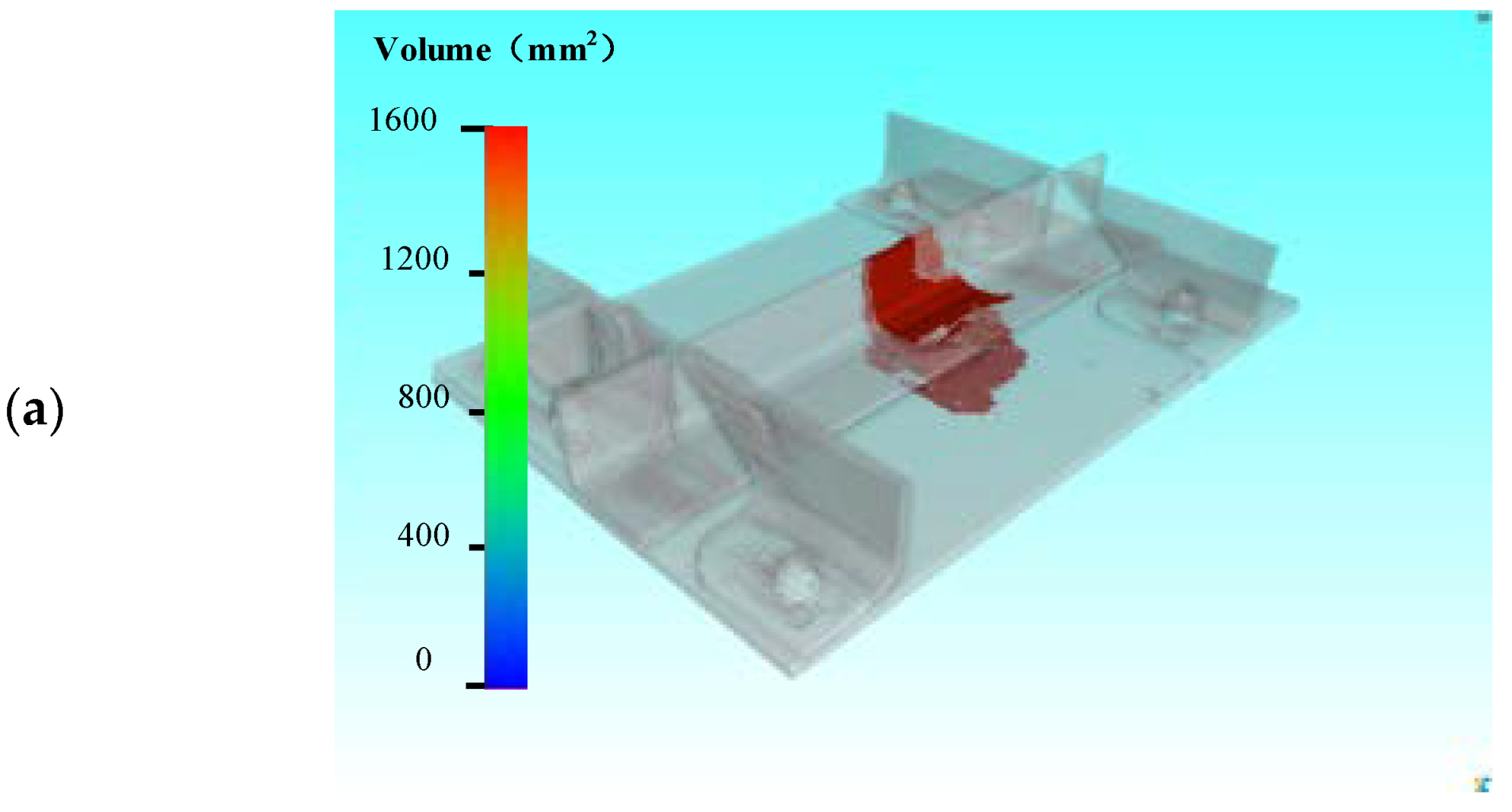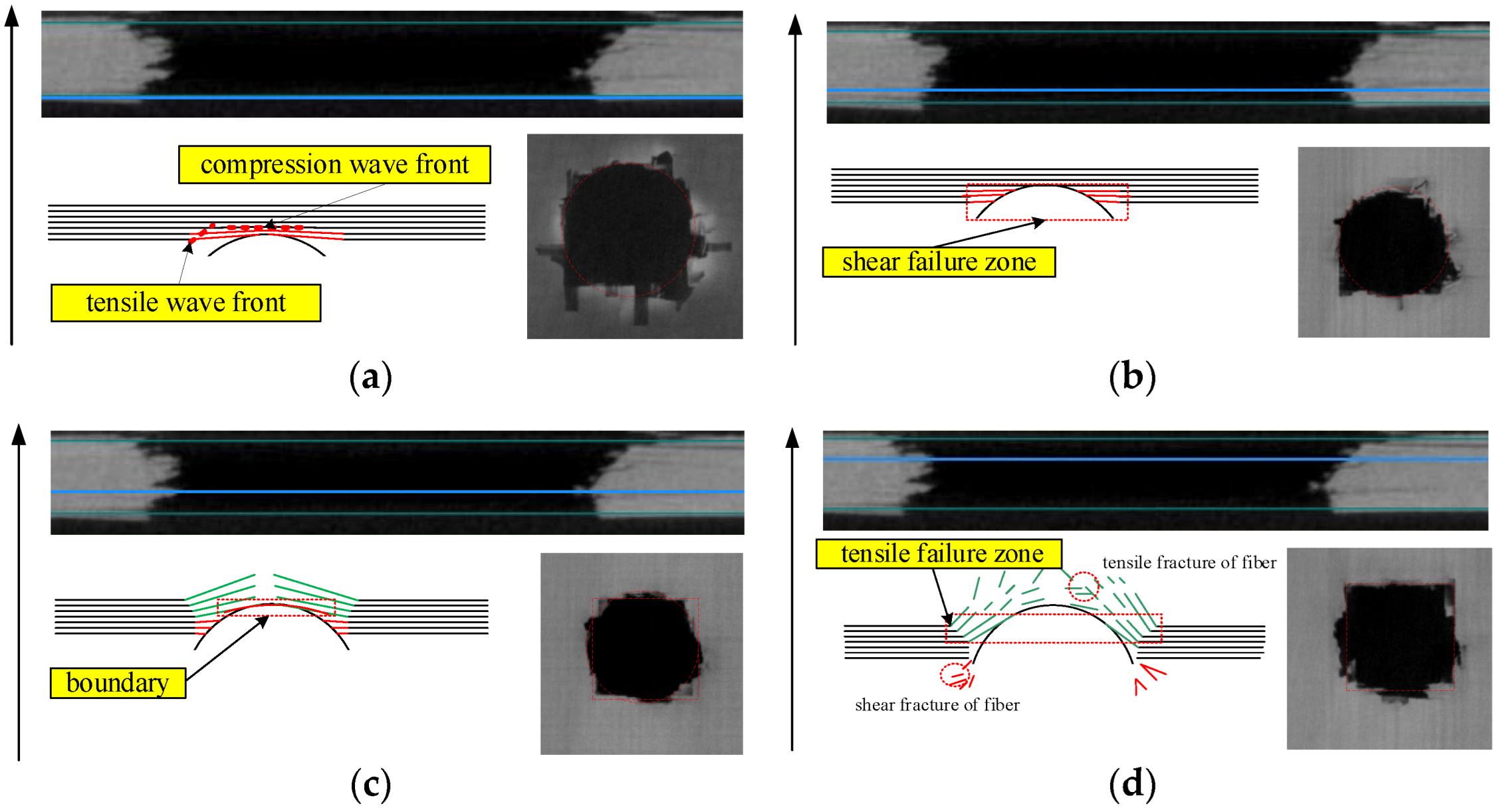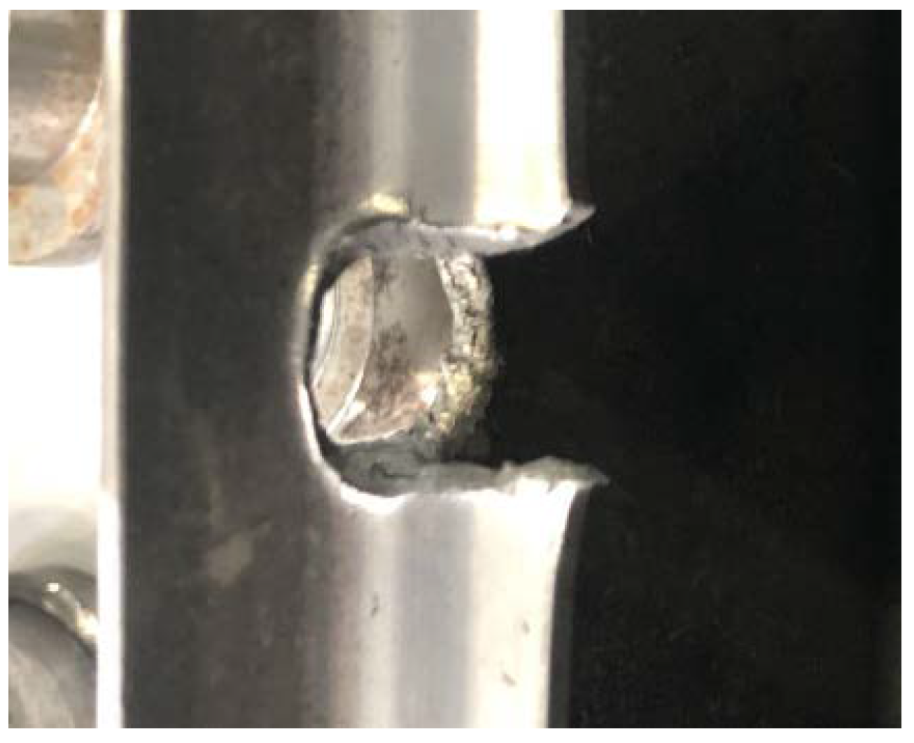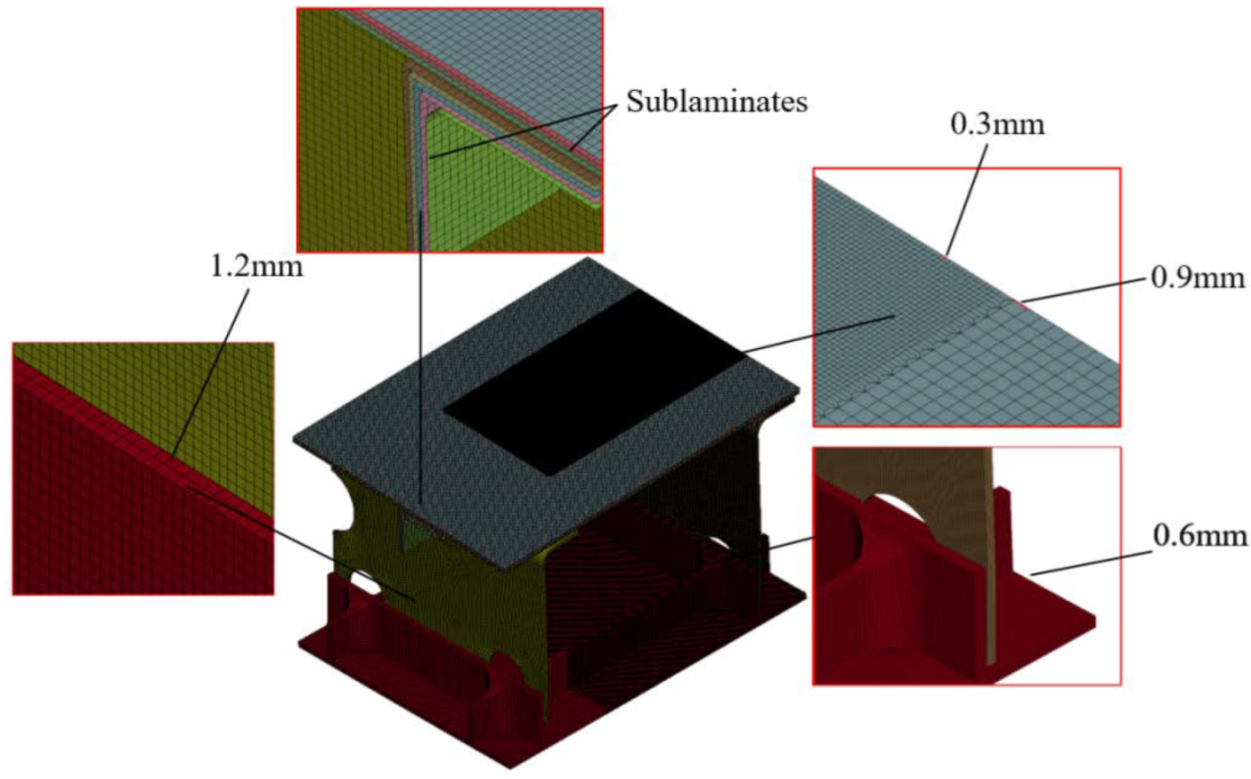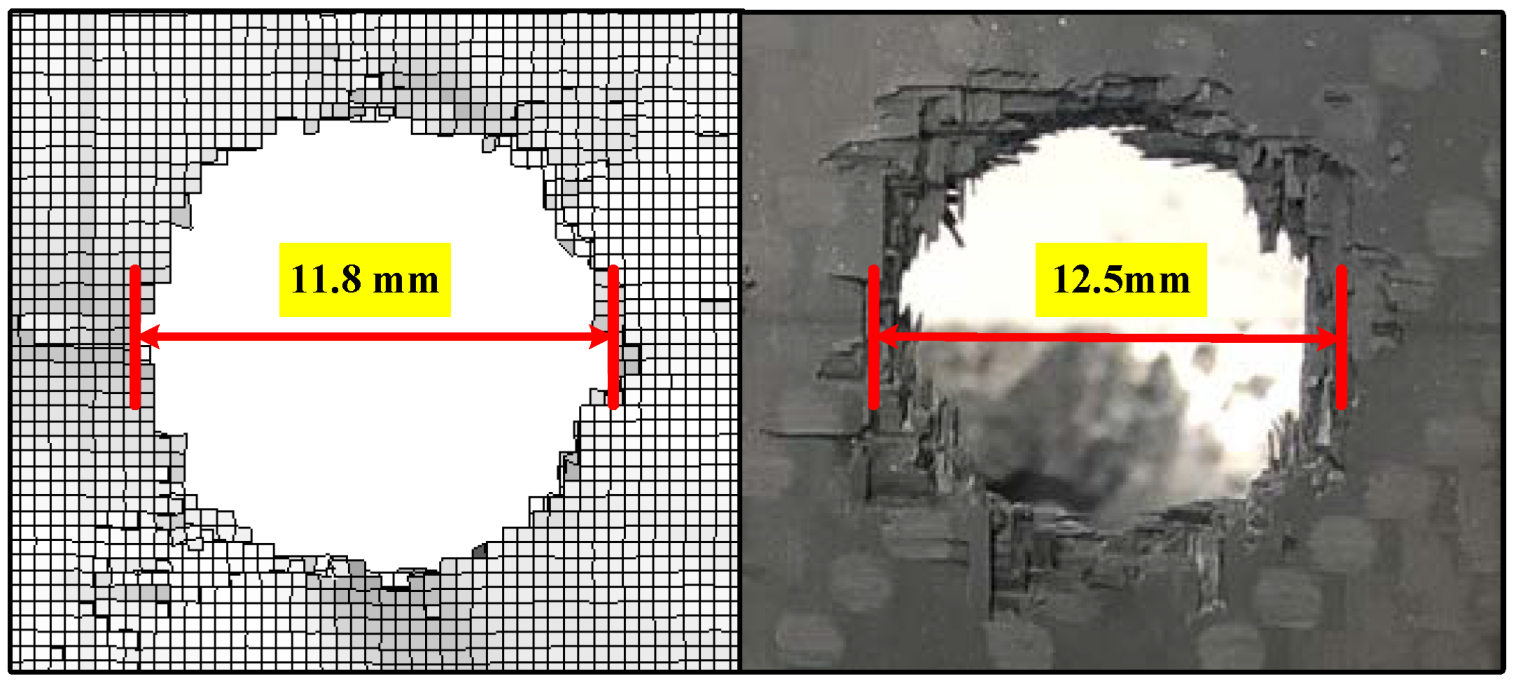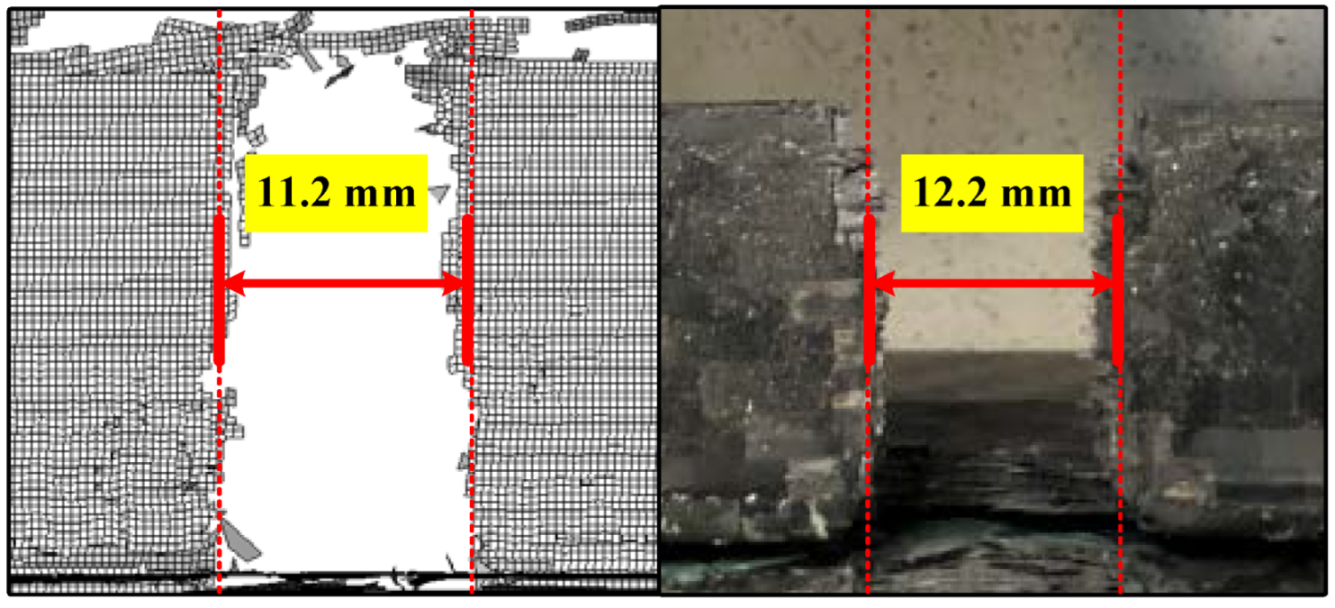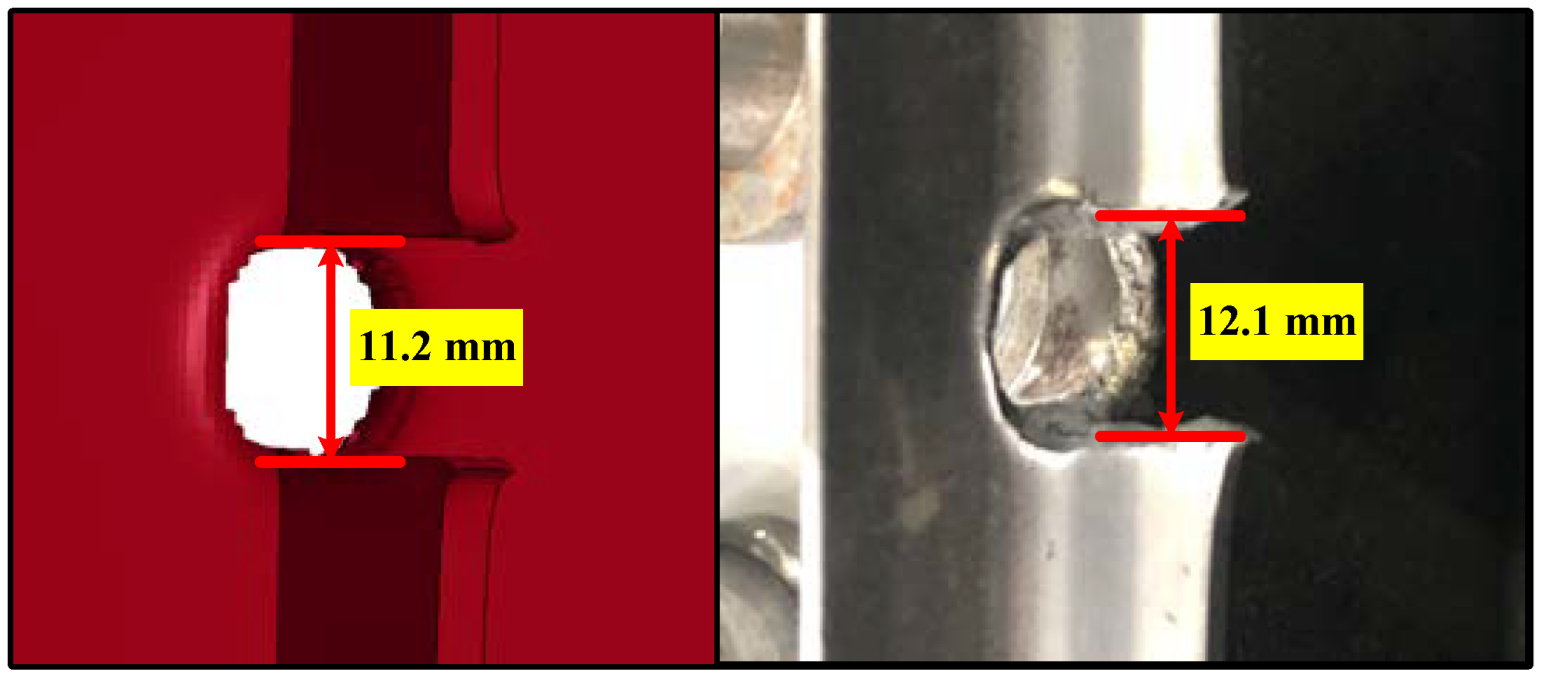3.1. Analysis of Impact Process
A high-speed camera (frame rate 160 kfps) is used to capture the dynamic process of the intersection of the spherical fragments with the structure, as shown in
Figure 8.
Situation 1: The fragment is incident from the bottom skin composite side at an incidence angle of 45°, and the measured fragment exit velocity is 2327 m/s. The moment the fragment intersects with the structure, a strong photo-thermal phenomenon is generated at the impact location, resulting in local overexposure of the high-velocity camera. Subsequently, the fragment penetrates the structure and forms a debris cloud on the outside of the structure, accompanied by a splash of massive fiber. As the invasion progresses, the composite laminate forms a bulge. The rapid rupture of the bulge forms a debris cloud, which is mainly composed of broken small-diameter carbon fiber particles. The outer debris cloud at the incident end expands radially along the vertical direction of fragment incidence, and its main components are bulk fiber debris and fragment metal particles, while the inner debris cloud at the incident end expands radially along the direction of fragment incidence, and its main components are small-diameter carbon fiber debris groups.
Situation 2: The dynamic intersection process of the fragment and structure in Situation 2 is similar to that shown in Situation 1. Due to the change in the direction of incidence, there is a difference in the expansion pattern of the debris cloud between the two. In Situation 2, the difference between the inner and outer debris cloud’s highlight phenomena is more obvious, again due to the difference in their main components. The small-diameter carbon fiber debris group has a black main layer with dense spatial distribution and strong light absorption, and the photo-thermal phenomena captured by the high-velocity camera in the inner part of the incident section are weak.
Situation 3: The fragment intruded from the top skin Al alloy side, and the photo-thermal phenomena were stronger both inside and outside. In Situation 1/2, when the projectile intrudes from the composite side, unlike the metal side, the carbon fiber breaks up to generate a large amount of dusty debris cloud, and the debris cloud is dominated by the carbon fiber debris, which will cover the entire high-velocity camera capture area, and the radial velocity is larger than the incident velocity during the expansion of the debris cloud. It is because the composite is made out of anisotropic material that when the impact direction is perpendicular to the fiber layup, the fiber is susceptible to shear fracture, and its normal strength is much lower than that of the metal material, resulting in a difference in the morphology of the bulge formed in the impact process, and therefore, the morphology of debris cloud diffusion formed in the final bulge rupture is also different. The shock photo-thermal phenomena in Situation 1/2 are not as obvious as in Situation 3, and the main component of the firelight is the high-temperature metal fragments. Due to the violent friction between steel spherical fragments and Al alloys during the impact penetration process, the temperature is extremely high, resulting in the appearance of small metallic debris and the release of part of the heat accumulated by friction in the pattern of luminescence.
3.2. Composite Damage Analysis
In Situation 1/2, the damage morphology of the structural composite top skin and the stringer intrusion by the high-velocity spherical fragments are shown in
Figure 9 and
Figure 10, respectively. The damage broken hole is mainly ellipsoidal under the 45° oblique impact of the fragment in Situation 1. In Situation 2, under the positive impact of fragment 0°, the damage broken hole is mainly in the pattern of regular spherical rupture. In Situation 1/2, there is fiber spalling on the outer surface of the incidence. The stringer part is thin and shows a band-like broken hole under the shearing effect in both Situation 1/2.
In Situation 3, the fragment is incident from the Al alloy metal side. According to
Figure 11, the fragment formed a debris cloud consisting of a large number of metal particles when it penetrated the top skin. The debris cloud still has a high kinetic energy, and the secondary damage formed at the bottom skin, which is mainly in the pattern of small-diameter broken holes and surface spalling, is widely distributed.
The test piece composite part was scanned by CT, and the damage morphology feature images of the composite test piece were obtained for each directional interface, layer by layer, and then the 3D view of the damage of the test piece composite part under each working condition was obtained by image rendering, as shown in
Figure 12.
The section of composite laminate damage area under high-velocity impact of spherical fragments is mainly in the pattern of a combination of cylindrical and circular truncated cones, as shown in
Figure 13. In his study on the impact damage of aramid laminate, Reddy pointed out that the damage aperture of thick plates decreases slightly along the thickness direction and then increases rapidly, while the aperture of thin plates expands in the shape of a circular truncated cone, and Cantwell et al. used the combined area of a cylindrical and circular truncated cone [
7,
8,
9]. In the early stage of projectile penetration, the front side of the laminate would generate a shear-plugging hole similar to the shape of the projectile contact area, where the matrix material is crushed and loses its support to the fiber, and shear failure occurs between the fiber and the surrounding fiber due to the presence of a large velocity gradient, which is called the shear failure zone (A). With the continuation of the penetration process, the projectile velocity decreases, the target plate bends, and with the continuous expansion of the bending deformation, fiber tensile failure occurs first in the outermost layer of the back side of the impact, and the tensile failure expands from the outer layer to the back side with a certain crack inclination angle and produces delamination, forming a fiber tensile failure zone behind the shear failure zone (B). Meanwhile, there is a small delamination damage zone around the shear failure zone/fiber tensile failure zone (C). In this test, the delamination zone of laminate caused by the high-velocity impact of spherical fragments is limited, and the fiber in the zone is mainly recoverable deformation without significant fiber damage.
The projection of the laminate damage area in the direction of fragment incidence shows different morphological features in different damage areas, as shown in
Figure 14. Herein, the position of the blue line is the position of the broken hole section in the vertical plane. On the upper surface of the shear failure zone, the main body of the broken hole section is circular. The laminate-free surface is strongly impacted by spherical fragments, and there are more striated fiber-stripping areas around the circular rupture holes. As the penetration progresses, the breach section inside the shear failure zone is mainly regular circular, and the area of the spalling zone decreases. At the shear failure zone/fiber tensile failure zone intersection, the breach section has common features of both. The shape of the breach section is transformed from a shear failure-oriented circle to a fiber tensile failure-oriented square. As the penetration progresses, the breach section in the fiber tensile failure zone appears as a regular square.
High-speed fragmentation spherical fragment intrusion CFRP, in the process of damage formation, can be divided into four stages as shown in
Figure 14. In shear and tensile damage, the compression wave generated by the spherical fragment acting on the target plate propagates faster than the projectile movement, and the strong tensile wave formed by the reflection of the compression wave on the back of the target plate meets the projectile, and the meeting point is the interface between shear damage and tensile damage. When the tensile stress is greater than the bonding strength of the fibers and the substrate or the tensile strength of matrix material, tensile stress is induced at the defective area and is accompanied by partial delamination. Eventually the fibers fracture and splash under the impact, which is in line with the phenomenon captured by the high-speed camera.
As shown in
Figure 15, from left to right are the upper surface, shear failure zone, area boundary, tensile failure zone, and lower surface of the broken hole morphology, respectively. The evolutionary pattern of breach section morphology shows a similar pattern under different velocities. Notably, as the fragment impact velocity decreases, the size of the laminate-free surface spalling area decreases significantly.
3.4. Numerical Modeling
In order to compensate for the limitation of the number of experiments, a fragment impact composite/metal connecting structure model based on LS-DYNA was established. In composite modeling, the * PART_COMPOSITE keyword is used to define the basic physical parameters such as the thickness of each layer of the composite carbon fiber laminate component, and the layup direction. In order to better reflect the loss between different layers independently in the modeling, and to take into account the computational scale and efficiency, a modeling scheme of one 2D shell cell layer is used instead of four to five actual layers, i.e., five 2D shell cell layers (i.e., elements in the meshing) are used in the simulation modeling instead of 25 actual layers of composite material for the bottom skin components, and five 2D shell unit layers are used instead of 22 actual layers of composite material for the stringer components.
The * MAT_COMPOSITE_DAMAGE model is a composite constitutive model commonly used on shell units, containing physical quantities such as density, fiber elastic modulus in three directions, Poisson’s ratio, shear modulus and longitudinal tensile strength, and transverse tensile strength, and can be used to define various orthogonal anisotropic materials with brittle fractures, which is applicable to the T300/QY8911 epoxy resin-based carbon fiber unidirectional laminate in this study. The single-layer carbon fiber laminate thickness direction size is much smaller than the other direction size. Hence, it can be analyzed according to the plane stress problem, considering only the in-plane stress state, ignoring the plane normal upward stress. The stress–strain relationship can be expressed as:
where σ is the stress, ε is the strain,
E is the elastic modulus, γ is the Poisson’s ratio, and
G is the shear modulus.
The * MAT_COMPOSITE_DAMAGE model uses the Chang–Chang failure criterion and has the following four failure modes:
- (1)
If
, fiber is in the stretched state, when satisfied:
Herein, and the fiber undergoes stretching failure;
- (2)
If
, the fiber is in compression, when the following conditions are met:
Herein, and the fiber fails in compression;
- (3)
If
, the fiber matrix is in a stretched state, when the following conditions are met:
Herein, and the fiber matrix undergoes a stretching failure;
- (4)
If
, the fiber matrix is in compression, when the following conditions are met:
Herein, and the fiber matrix fails in compression.
The Johnson–Cook constitutive model, Mie–Gruneisen equation of state, and maximum tensile stress damage criterion were used for the Al alloy in the structure. The Johnson–Cook model [
10] differs from the common plastic theory in that it characterizes the material response to impact and penetration through parameters such as processing hardening, deformation rate effects and thermal softening. Each parameter is multiplied to characterize the cumulative effect of each effect.
In Equation (7),
is the effective plastic strain;
, where
ε0 is the strain rate used to determine
A,
B, and
n;
is the homologous temperature;
TM is the melting temperature;
TR is the reference temperature;
, where
ρ is the density, and
CP is the specific heat. The five parameters
A,
B,
n,
m and
C in the model are basic parameters for characterizing the yield strength, where
A is the initial yield strength of the material under the quasi-static strain rate,
B and
n are the flow stress of the strain-hardening behavior under the quasi-static strain rate,
C is the strain rate effect, and
m is the thermal softening effect. In addition to the material properties
ρ,
CP, and
TM, there are also elastic parameters. Usually, the pressure is defined as a function of the volume strain response, and the shear modulus is integrated along the equation of state [
11].
The cumulative damage of the material is used to characterize the failure of the material in the J-C constitutive, as shown in Equation:
where
the material failure occurs when
D = 1 where
is the effective stress,
P is the average stress. The parameters of the Johnson–Cook model for the Al7075-T6Al alloy and the parameters of the Mie–Gruneisen equation of state are shown in
Table 1 [
12].
T300/QY8911 related material parameters are shown in
Table 2.
The simulated spherical fragments are divided by a uniform mesh with a mesh size of about 0.3 mm, using hexahedral eight-node units with a total number of 56,000 units, as shown in
Figure 19.
The structural metal part of the model mesh uses a hexahedral deca-node unit, and the composite part of the model consists of a 2D shell unit, with a single sub-layer containing three layers of actual layup information. * CONTACT_SURFACE_TO_SURFACE_TIEBREAK [
15,
16] is used between layers. The total number of model units for the air inlet Al alloy I-beam riveted structure is 241,437, and the total number of model units for the wing composite/Al alloy spacer structure is 1,099,060. In order to improve the overall computational efficiency and ensure the computational accuracy, the local mesh refinement method is used to divide the model into two density meshes, where the impact penetration part is encrypted mesh, and the two are connected by the trapezoidal transition mesh co-node method, as shown in
Figure 20.
The fragment is set up with * CONTACT_AUTOMATIC_SURFACE_TO_SURFACE automatic face-to-face contact and * CONTACT_AUTOMATIC_SINGLE_SURFACE automatic single-sided contact between the fragment and the structure.
Typical damage modes of the composite bottom skin and stringer obtained by experiments and simulation are shown in
Figure 21 and
Figure 22, respectively. In terms of characteristic damage size, the diameter of openings and penetrations obtained from the simulation is close to that of the test. Since the composite simulation model uses 2D shell unit modeling, it cannot simulate the damage morphology of fiber fracture and spalling, and the Mat_Composite_Damage model does not consider the effect of temperature on overall damage. However, there is a small amount of fiber-melting phenomena in the actual test. Therefore, the characteristic damage size of a composite obtained from simulation is relatively small compared with the actual one, but the relative error is not big, and it can meet the requirements of battle damage size prediction to some extent. In terms of the Al alloy side damage morphology, the simulated results are in high agreement with the test, and the difference in feature size is small, as shown in
Figure 23.
Figure 24 shows the kinetic energy curve of the fragment at a speed of 2400 m/s (kinetic energy = 6 kJ) from the composite side (Situation 2) and the metal side (Situation 3), respectively. The fragment is almost always linearly decaying during the intrusion. At a constant thickness, the kinetic energy dissipation of the fragment is greater for the carbon fiber composite layer, while the Al alloy layer is insensitive to the kinetic energy dissipation of the secondary penetration of the fragment, and the kinetic energy of the fragment decays rapidly to 0 during the secondary penetration of the composite layer.


